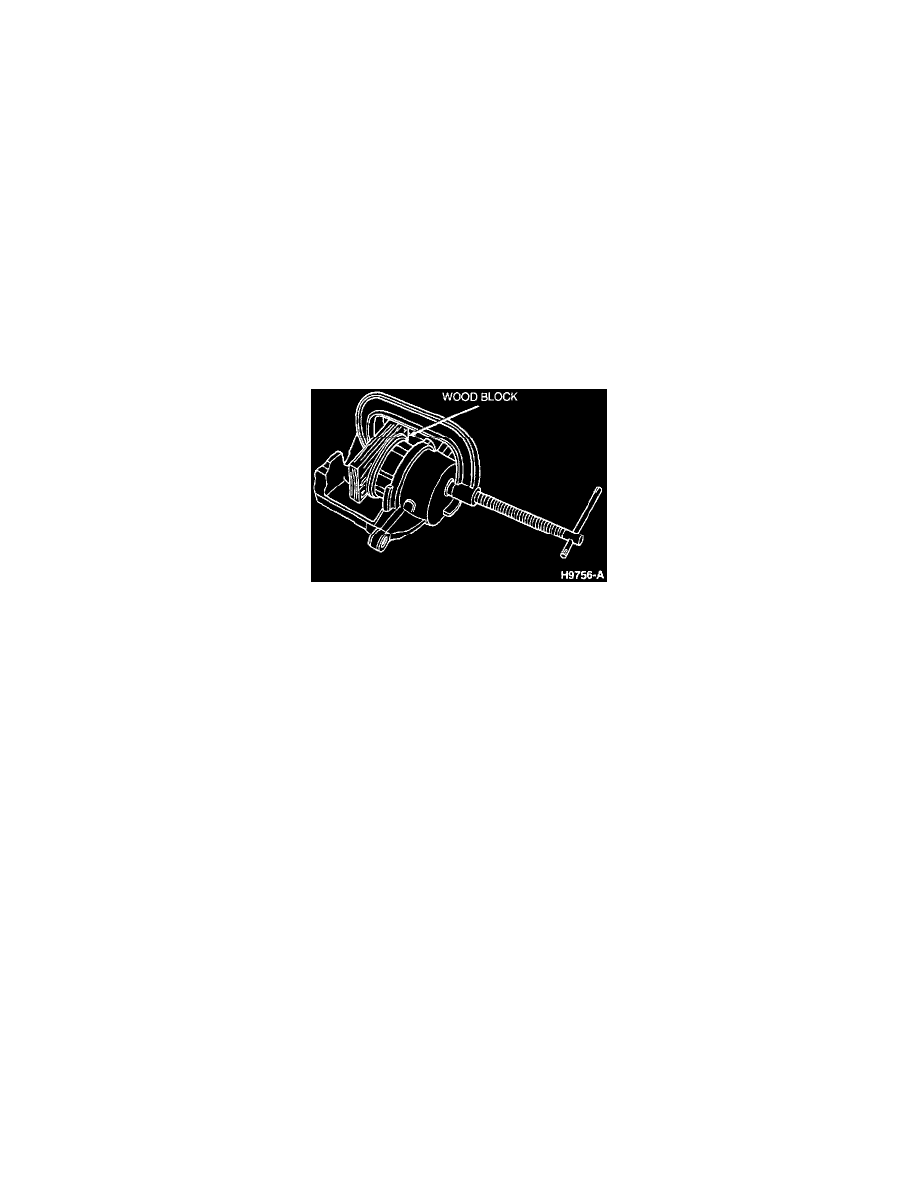Sable V6-183 3.0L DOHC VIN S MFI (1997)

- To prevent damage, do not allow disc brake caliper to hang by the front brake hose.
- It is not necessary to disconnect hydraulic connections.
3. Position disc brake caliper out of the way.
4. Remove inner and outer brake shoe and lining assembly from front disc brake caliper anchor plate.
NOTE: If rotor is to be removed, use touch-up paint to mark a stud and the rotor to ensure proper realignment.
5. Inspect both rotor braking surfaces. Minor scoring or buildup of lining material does not require machining or replacement of front disc brake
rotor.
6. Hand-sand glaze from both rotor braking surfaces using garnet paper 100A (medium-grit) or aluminum oxide 150-J (medium).
INSTALLATION
NOTE: If front disc brake rotor has been moved relative to the wheel hub and rust or dirt may have shifted between front disc brake rotor and
wheel hub, on-vehicle rotor runout can be increased significantly. This can lead to brake shudder. Check Brake Rotor, Disc Runout. Clean all dirt
or foreign material from mating surfaces of caliper locating pins and caliper housing ears. Dirt can cause caliper locating pins to be crooked after
rear brake pin retainers are torqued preventing disc brake caliper from sliding properly.
CAUTION: Metal or sharp objects cannot come into direct contact with piston surface or damage will result.
Retracting Caliper
1. Use a 10 cm (4-inch) C-clamp and a wood block or other flat stock, like an old brake shoe and lining to press hydraulic caliper piston into its bore.
This must be done to provide clearance for disc brake caliper to fit over front disc brake rotor during installation. Extra care must be taken during
this procedure to prevent damage to metal caliper piston.
2. Remove all rust buildup from inside of disc brake caliper shoe contact areas.
3. Install inner and outer brake shoe and lining assembly with clip-on insulators into front disc brake caliper anchor plate.
4. Make sure lining material is facing front disc brake rotor. Install disc brake caliper over front disc brake rotor and brake shoes and linings.
5. Install rear brake pin retainer through front disc brake caliper holes into disc brake caliper locating pins and hand start.
NOTE: To make sure correct disc brake caliper is installed on correct side of vehicle. The bleeder screw should be on top of disc brake caliper
when assembled on vehicle.
6. Tighten two brake pin retainers to 31-38 Nm (23-28 ft. lbs.).
NOTE:Always re-install rubber bleed screw cap after bleeding.
7. Bleed the serviced disc brake caliper.
Manual Bleeding
NOTE: When the brake system is emptied or partially emptied, fluid may not flow from the bleeder screws during normal bleeding. It may be
necessary to prime the system by performing the Master Cylinder Bleeding procedure.
1. To bleed brake system, position suitable box wrench on bleeder fitting. Attach rubber drain tube to bleeder fitting. The end of tube should fit
snugly around bleeder fitting.
2. Submerge free end of the tube in container partially filled with clean brake fluid and loosen bleeder fitting approximately three-quarters of a turn.
3. Have assistant push brake pedal down slowly through its full travel. Close bleeder fitting and return the brake pedal to full release position.
4. Repeat Steps 2 and 3 until air bubbles cease to appear at submerged end of bleeder tube.
5. When fluid is completely free of air bubbles, secure bleeder fitting and remove bleeder tube.
6. Refill brake master cylinder reservoir after each system is bled and install master cylinder reservoir cap and gasket. Make sure diaphragm type
gasket is properly positioned in master cylinder reservoir cap. When bleeding operation is completed, fluid level should be between MAX line and
4.0 mm (0.16 inch) below.
